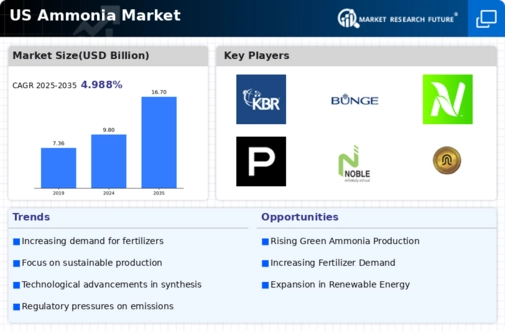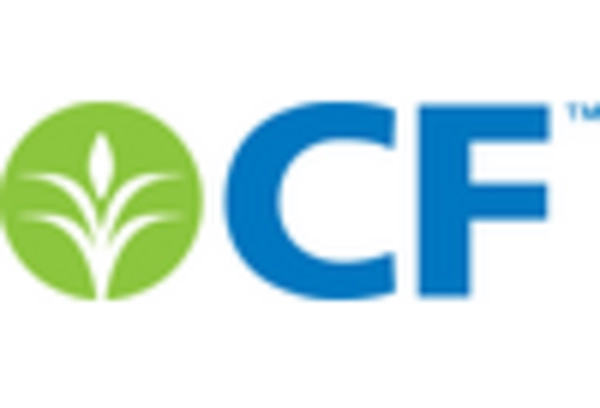The ammonia market exhibits a complex competitive landscape characterized by a blend of established players and emerging innovators. Key growth drivers include the increasing demand for fertilizers, particularly in the agricultural sector, and the push towards sustainable production methods. Major companies such as CF Industries Holdings Inc (US), Yara International ASA (NO), and Nutrien Ltd (CA) are strategically positioned to leverage these trends. CF Industries, for instance, focuses on enhancing its production efficiency and expanding its operational footprint, while Yara emphasizes digital agriculture solutions to optimize fertilizer use. Nutrien, on the other hand, is investing in sustainable practices, which collectively shapes a competitive environment that is increasingly focused on innovation and sustainability.
In terms of business tactics, companies are localizing manufacturing to reduce transportation costs and enhance supply chain resilience. The market structure appears moderately fragmented, with several key players exerting significant influence. This fragmentation allows for competitive dynamics where companies can differentiate themselves through unique value propositions, such as sustainability initiatives or advanced technological integration.
In October 2025, CF Industries Holdings Inc (US) announced a partnership with a leading technology firm to develop AI-driven solutions aimed at optimizing ammonia production processes. This strategic move is likely to enhance operational efficiency and reduce costs, positioning CF Industries favorably in a market that increasingly values technological advancements. The integration of AI into production processes may also lead to improved sustainability outcomes, aligning with broader industry trends.
In September 2025, Yara International ASA (NO) launched a new digital platform designed to provide farmers with real-time data on soil health and nutrient requirements. This initiative underscores Yara's commitment to digital transformation and its strategic focus on precision agriculture. By equipping farmers with actionable insights, Yara not only enhances its product offerings but also strengthens customer loyalty, which is crucial in a competitive market.
In August 2025, Nutrien Ltd (CA) expanded its operations by acquiring a regional fertilizer distributor, thereby enhancing its market presence in the Midwest. This acquisition is indicative of Nutrien's strategy to consolidate its position in key markets and improve supply chain efficiencies. The move is expected to facilitate better service delivery to customers and increase market share, reflecting a trend towards consolidation in the ammonia sector.
As of November 2025, the ammonia market is increasingly defined by trends such as digitalization, sustainability, and the integration of advanced technologies. Strategic alliances are becoming more prevalent, as companies recognize the need to collaborate to enhance innovation and operational efficiency. Looking ahead, competitive differentiation is likely to evolve from traditional price-based competition to a focus on innovation, technology adoption, and supply chain reliability. This shift suggests that companies that prioritize these areas will be better positioned to thrive in an increasingly competitive landscape.

















Leave a Comment